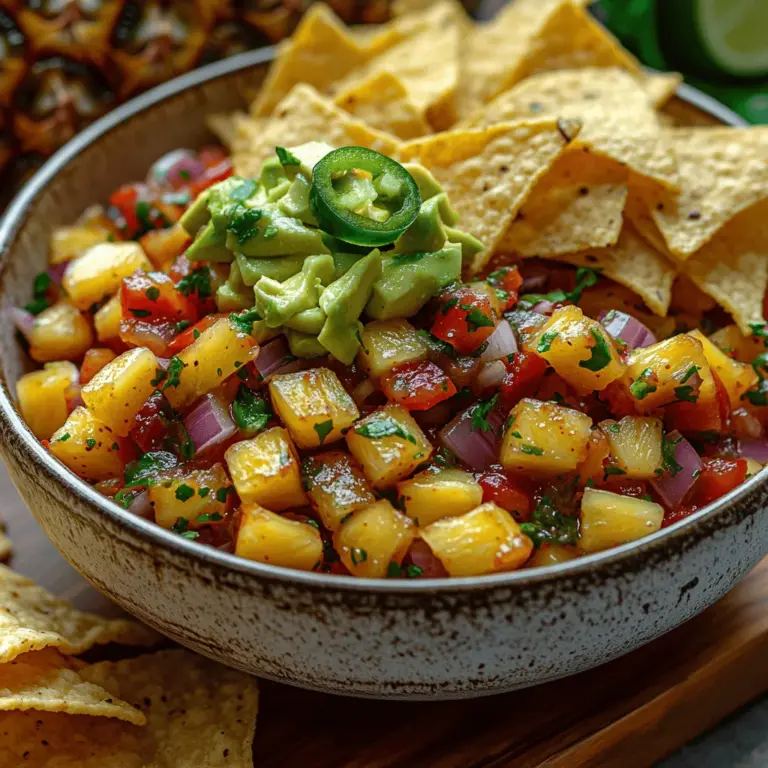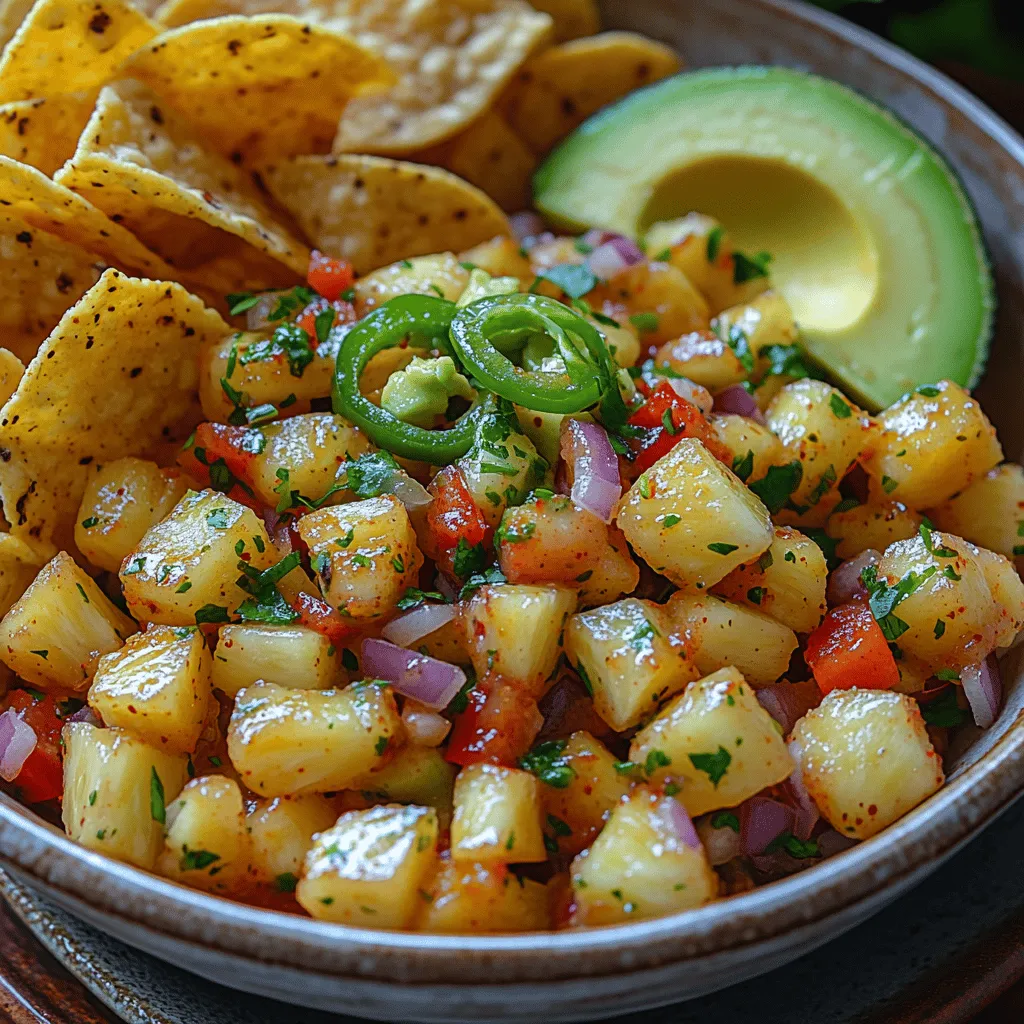Introduction
If you’re looking to brighten up your meals with a burst of fresh flavor, look no further than tropical pineapple salsa. This vibrant and zesty dish not only adds a tropical flair to your table but also serves as a perfect accompaniment to grilled meats, tacos, or simply enjoyed with crispy tortilla chips. What makes this salsa truly special is its reliance on fresh, high-quality ingredients that harmonize beautifully, creating an explosion of flavor in every bite.
The charm of salsa lies in its versatility; it can be a dip, a topping, or even a salad. Pineapple salsa, in particular, brings a unique sweetness and acidity that is hard to resist. Whether you are hosting a summer barbecue, celebrating a festive occasion, or simply enjoying a quiet dinner at home, this tropical salsa is sure to impress your guests and elevate your culinary experience.
Understanding the Tropical Pineapple Salsa
Salsa, a Spanish word meaning “sauce,” has transcended its traditional roots to become a beloved staple in kitchens around the world. Originating from Mexican cuisine, salsa is not just one recipe but a category of sauces that can vary widely in ingredients and preparation methods. Its cultural significance is profound, often serving as a symbol of celebration and togetherness in social gatherings.
In contemporary cuisine, tropical flavors have gained immense popularity, reflecting a growing appreciation for fresh, bold tastes. Ingredients like pineapple, mango, and papaya are being incorporated into various dishes, adding a refreshing twist that tantalizes the palate. Pineapple, in particular, stands out as an excellent base for salsa due to its natural sweetness, juiciness, and vibrant color. The tropical fruit complements savory ingredients beautifully, making it a go-to choice for those looking to create a bright and flavorful condiment.
The Appeal of Pineapple in Salsa
Pineapple is not just delicious; it’s packed with nutritional benefits that make it a smart choice for any dish. Rich in vitamins C and B6, manganese, and dietary fiber, pineapple offers a range of health benefits, including anti-inflammatory properties and digestive support. When used in salsa, the fruit’s natural sugars contrast perfectly with the heat from peppers and the acidity from lime juice, creating a well-rounded flavor profile that is both exciting and satisfying.
Ingredient Breakdown
Creating the perfect tropical pineapple salsa involves selecting the right combination of fresh ingredients. Each component plays a crucial role in not only enhancing the flavor but also contributing to the overall texture and appearance of the dish. Here’s a closer look at the key ingredients you’ll need:
Fresh Pineapple
The star of the show, fresh pineapple, is essential for achieving that authentic tropical flavor. When selecting a pineapple, look for one that is fragrant and has a slight give when pressed. The color should be a rich golden yellow, indicating ripeness. Avoid pineapples with dark spots or a dull appearance, as these may indicate overripeness.
Nutritional Benefits: Pineapple is a powerhouse of nutrients, providing a healthy dose of vitamin C, which supports immune function, and bromelain, an enzyme that aids in digestion. Incorporating fresh pineapple into your diet can contribute to overall health and well-being.
Red Bell Pepper
Adding a pop of color and sweetness, red bell pepper enhances both the flavor and visual appeal of your salsa. Its crisp texture contrasts beautifully with the juicy pineapple, providing a satisfying crunch.
Health Benefits: Red bell peppers are rich in vitamins A and C, as well as antioxidants, making them a nutritious addition to your salsa.
Red Onion
Red onion brings a mild sweetness and vibrant color to the salsa. Its sharp taste balances the sweetness of the pineapple, creating a complex flavor profile that tantalizes the taste buds.
Importance in Salsa: The red onion also adds a beautiful visual element, making your salsa more appealing. When finely diced, it integrates seamlessly into the mix, providing flavor without overpowering the other ingredients.
Jalapeño Pepper
For those who enjoy a bit of heat, jalapeño pepper is the perfect addition to pineapple salsa. It delivers a mild to moderate spice level that can be adjusted according to your personal preference.
Adjusting Spice Levels: To control the heat, you can remove the seeds and membranes before chopping the jalapeño. For a milder salsa, start with a small amount and gradually increase to taste.
Fresh Cilantro
Cilantro adds a fresh, herbaceous note that brightens the salsa and enhances the overall flavor. Its distinct taste pairs well with the sweetness of the pineapple and the heat of the jalapeño.
Role in Traditional Salsas: Fresh cilantro is a staple in many traditional salsa recipes, contributing to the dish’s aromatic qualities. If you’re not a fan of cilantro, you can substitute it with parsley for a different but equally refreshing flavor.
Lime Juice and Zest
Lime juice and zest are crucial for adding acidity to your salsa, which helps balance the sweetness of the pineapple. The bright, tangy flavor of lime elevates the dish, making it more refreshing and vibrant.
Impact on Flavor Balance: Acidity is essential in salsa as it enhances the overall flavor profile, making each bite more dynamic. Freshly squeezed lime juice is highly recommended, as bottled varieties can lack the freshness needed for this dish.
Ground Cumin
While optional, ground cumin can add depth and warmth to your salsa, providing an earthy note that complements the tropical flavors. A small pinch can go a long way in enhancing the complexity of your dish.
Avocado and Tortilla Chips
To serve your pineapple salsa, consider pairing it with creamy avocado and crispy tortilla chips. The rich texture of avocado balances the salsa’s sweetness and acidity, while tortilla chips provide the perfect vehicle for scooping up all that deliciousness.
Step-by-Step Preparation Guide
Now that you have a solid understanding of the ingredients needed for your tropical pineapple salsa, it’s time to prepare them. Proper preparation is key to achieving a salsa with even texture and vibrant flavors. Here are the essential steps to get you started:
Preparing the Ingredients
1. Pineapple: Start by cutting off the top and bottom of the pineapple to create a stable base. Stand the pineapple upright and slice off the skin, following the curve of the fruit. Once peeled, cut the pineapple into quarters and remove the core from each section. Finally, dice the fruit into small, even pieces to ensure uniformity in your salsa.
2. Red Bell Pepper: Slice the bell pepper in half and remove the seeds and white membranes. Chop the pepper into small, bite-sized pieces, similar in size to the pineapple for a cohesive texture.
3. Red Onion: Peel the red onion and slice it in half. Lay each half flat and finely dice the onion. Aim for small pieces to ensure they mix well into the salsa without overpowering the other flavors.
4. Jalapeño Pepper: Wearing gloves, cut the jalapeño in half lengthwise and remove the seeds and membranes if you prefer a milder salsa. Finely chop the jalapeño, adjusting the amount based on your desired spice level.
5. Cilantro: Rinse the cilantro under cold water and shake off any excess moisture. Remove the leaves from the stems and finely chop the leaves.
6. Lime Juice and Zest: Zest the lime using a microplane or zester, being careful not to include the bitter white pith. Cut the lime in half and squeeze out the juice, making sure to remove any seeds.
7. Mixing the Ingredients: In a large mixing bowl, combine the diced pineapple, red bell pepper, red onion, jalapeño, and cilantro. Drizzle the lime juice over the mixture, add the lime zest, and season with salt to taste. If using ground cumin, sprinkle in a pinch at this stage.
8. Tasting and Adjusting: Mix all the ingredients thoroughly and taste the salsa. Adjust the seasoning as needed, adding more lime juice, salt, or jalapeño based on your preferences.
This tropical pineapple salsa is now ready to shine at your next gathering or serve as a delicious addition to your meals. The combination of fresh, colorful ingredients ensures a delightful burst of flavor that will leave everyone wanting more. Enjoy the refreshing taste of the tropics with every scoop!
Combining the Ingredients
When preparing your Tropical Pineapple Salsa, the method of combining the ingredients can significantly affect the final texture and flavor profile. To ensure that your salsa maintains a fresh and vibrant appearance, it’s crucial to mix the ingredients gently, particularly the delicate fruits like pineapple and avocado.
Begin by placing your diced pineapple in a large mixing bowl. Then, add the finely chopped red onion, jalapeño, and bell pepper. For combining these ingredients without bruising the fruits, use a rubber spatula or a wooden spoon. This tool allows for gentle folding rather than aggressive stirring.
Start by incorporating the sturdier ingredients—like the onion and bell pepper—before adding the more delicate ones, such as diced avocado. Fold the mixture gently, ensuring that all ingredients are well combined while still preserving their individual textures. Once everything is mixed, let it rest for a few minutes. This brief period allows the flavors to meld beautifully, enhancing the overall taste of your salsa.
Adding Fresh Herbs and Zest
The addition of fresh herbs and citrus zest is a critical step in developing the flavor profile of your Tropical Pineapple Salsa. Timing is key; it’s best to add these ingredients right before serving. Fresh herbs, such as cilantro and mint, lose their aromatic qualities when they are exposed to air for too long, so adding them at the last minute ensures maximum freshness and flavor.
Start by finely chopping a handful of fresh cilantro. For a unique twist, consider adding a bit of mint for an extra layer of freshness. After incorporating the herbs, don’t forget to add lime or lemon zest. The zest from citrus fruits contains essential oils that provide a burst of flavor, enhancing the overall brightness of the salsa.
Mix the herbs and zest into the salsa gently, ensuring that they are evenly distributed throughout the mixture. This step not only elevates the taste of your salsa but also adds an appealing visual contrast with the vibrant green of the herbs against the bright yellow and red ingredients.
Seasoning the Salsa
Achieving the perfect balance of flavors is essential for a delicious Tropical Pineapple Salsa. Start by seasoning the mixture with salt and pepper. When adding salt, remember that it enhances the sweetness of the pineapple while balancing the heat from the jalapeño. Start with a small pinch and taste as you go; you can always add more if needed.
For an added depth of flavor, consider incorporating a sprinkle of cumin or a dash of chili powder. These spices can introduce a warm, earthy note that complements the sweetness of the pineapple. Additionally, a splash of apple cider vinegar or a squeeze of fresh lime juice can add the acidity needed to brighten the dish, making the flavors pop.
Taste your salsa as you go, adjusting the seasoning to your preference. Remember that the flavors will develop and intensify after resting, so allow your salsa to sit for about 30 minutes before serving to let the ingredients marry.
Serving Suggestions
Tropical Pineapple Salsa is incredibly versatile and can elevate a variety of dishes. Here are some creative ideas to inspire you:
1. Grilled Fish: Serve your salsa over grilled fish like mahi-mahi or salmon. The sweetness of the pineapple beautifully complements the rich flavor of the fish, creating a delightful contrast.
2. Chicken Tacos: Use the salsa as a topping for chicken tacos. The fresh, zesty notes will brighten up the dish and add a refreshing crunch.
3. Summer Salads: Incorporate the salsa into a summer salad. It pairs wonderfully with mixed greens, avocado, and grilled chicken or shrimp for a light, nutritious meal.
4. Appetizer Dip: Serve the salsa as a dip with tortilla chips or alongside a cheese platter. It adds a tropical twist that is sure to impress guests at any gathering.
5. Bowl Meals: Use the salsa as a topping for grain bowls. Combine it with quinoa or brown rice, black beans, and grilled vegetables for a wholesome meal.
Flavor Profiles and Pairing Suggestions
The Tropical Pineapple Salsa showcases a delightful balance of flavors that can elevate any dish. The sweetness of the pineapple provides a refreshing contrast to the spiciness of the jalapeño, creating a harmonious blend that tantalizes the taste buds. The acidity from lime juice or vinegar cuts through the sweetness, refreshing the palate and enhancing the overall flavor profile.
When considering pairing ideas, grilled fish is an excellent option. The natural sweetness of the pineapple salsa works beautifully with the savory, charred flavors of grilled seafood. Additionally, chicken tacos benefit from the salsa’s bright flavors, making them a perfect match for a summer evening meal.
Moreover, the salsa can complement a variety of summer salads, especially those featuring fresh greens, beans, or avocados. Its vibrant colors and flavors bring a burst of tropical essence that can transform a simple salad into a gourmet experience.
Nutritional Benefits of Tropical Pineapple Salsa
Incorporating Tropical Pineapple Salsa into your diet not only adds flavor but also provides numerous health benefits. Pineapple is rich in vitamins C and B6, manganese, and dietary fiber, which supports digestion and overall health. The addition of fresh vegetables like red onion and bell pepper increases the nutrient density of the salsa, providing antioxidants and essential vitamins.
The caloric content of this salsa is relatively low, with approximately 40-50 calories per serving, making it an excellent choice for those watching their intake. Fresh salsas like this one are ideal for enhancing a balanced diet, as they are packed with nutrients while adding flavor without excess calories.
Including fresh salsas in your meals encourages a diet rich in fruits and vegetables, promoting overall well-being. The vibrant ingredients in this salsa not only make for a delicious side dish but also contribute to the intake of essential nutrients.
Storage and Shelf Life
To ensure the best quality and flavor, proper storage of your Tropical Pineapple Salsa is key. After preparing the salsa, it can be stored in an airtight container in the refrigerator. It is best consumed within 2-3 days to enjoy its freshness.
If you want to maintain the salsa’s vibrant flavors, avoid adding delicate ingredients like avocado until you’re ready to serve. When stored, the flavors will continue to meld, enhancing the taste, but the texture of the fruits may soften over time.
If you have leftovers, consider using them creatively. Incorporate the salsa into omelets, use it as a topping for grilled meats, or blend it into a smoothie for a tropical twist. The possibilities are endless!
Conclusion
Tropical Pineapple Salsa is a vibrant, refreshing addition to a variety of dishes, perfect for summer gatherings or a simple weeknight meal. Its versatility allows for endless experimentation with different ingredients, making it a staple in any kitchen.
Encouraging creativity in the kitchen, this salsa invites you to explore various pairings and flavors, whether you’re serving it at a barbecue or enjoying it as a light snack. The joy of sharing homemade salsa with friends and family at gatherings and celebrations is an experience that enhances any occasion. So, grab some fresh ingredients, whip up a batch of Tropical Pineapple Salsa, and savor the flavors of summer!


